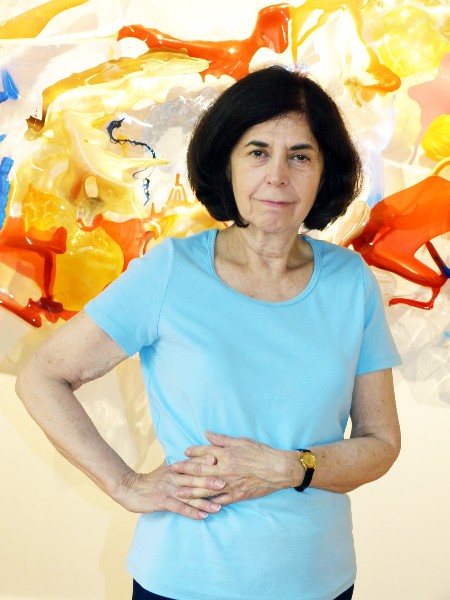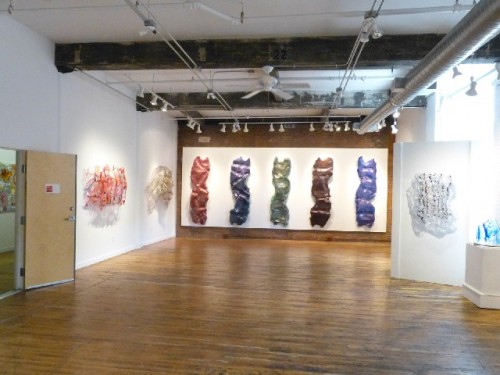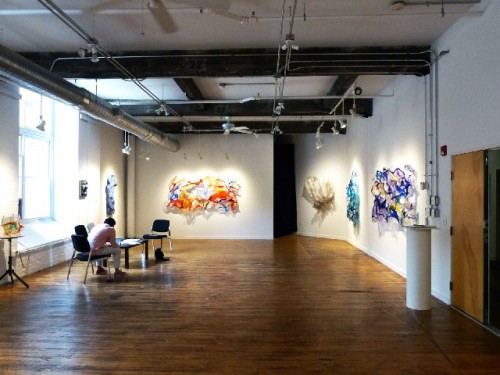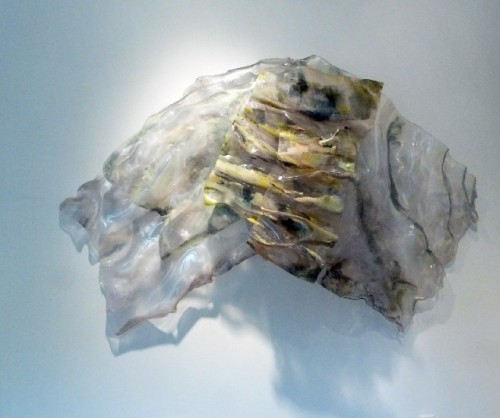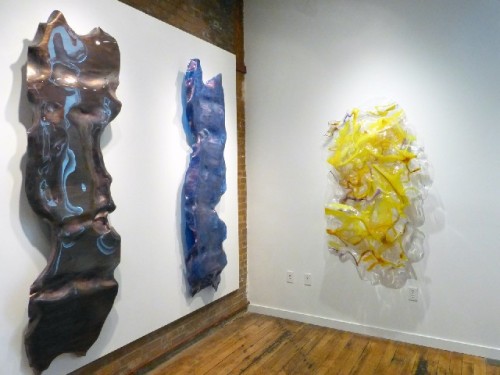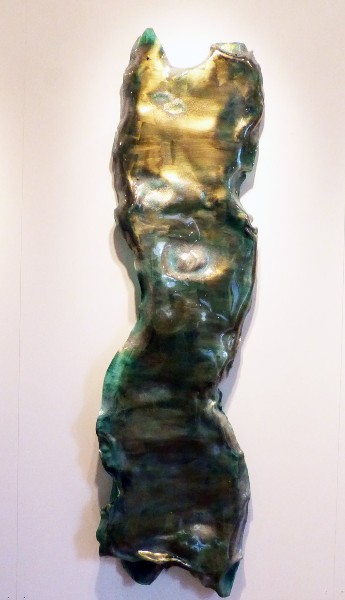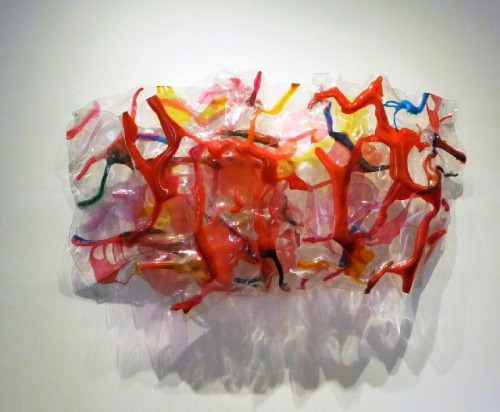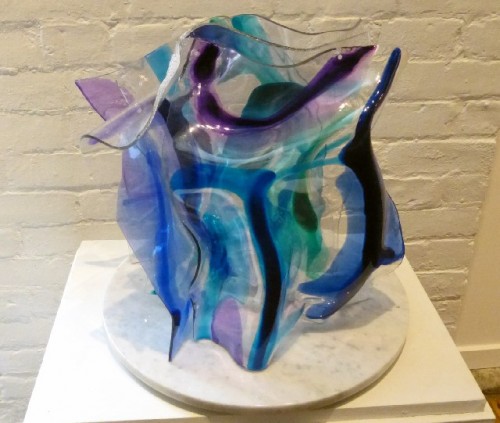Marjorie Minkin’s Lexan Painted Reliefs
Collaborations with Her Son Mike Gordon of Phish
By: Charles Giuliano - Jul 28, 2014
Recently we sat with North Adams/ Waltham based artist Marjorie Minkin during the final days of her exhibition, now closed, at the Eclipse Mill Gallery where she maintains a studio residence. She was a part of the crit group of Clement Greenberg, the most influential American art critic of his generation. That dialogue continues with curator and critic, Kenworth Moffett, the founding curator of the department of contemporary art at the Museum of Fine Arts. He recently wrote an essay about her work.
With her son Mike Gordon, the bass player of the well known band Phish, and engineer Jamie Robertson, they collaborated on a series of 22 interactive sound and relief works.
Charles Giuliano We are surrounded by your exhibition at the Eclipse Mill Gallery.
Marjorie Minkin It’s call Evolution referring to my development as an artist and working with Lexan as a material. I started by doing works on canvas which I still do. I created broad sweeps of veiled color on top of each other. I was doing Color Field Paintings but looking for ways to increase the layering and space. There were experiments with all kinds of clear plastic attaching it to the front and back. Then painting on it. Eventually I discovered polycarbonate with the product name Lexan.
It comes in sheet form and looks similar to plexiglass. It’s not an acrylic. It’s a different formula. It’s stronger and used for ship and airplane windows, medical machinery, and eye glasses.
I was buying plastics at a company outside Boston and one of the associates recommended it. I liked it because I could bend it more easily in order to attach it to the back of the canvas. Then I realized it would be interesting to do some bends in the middle.
CG How do you bend it?
MM I use an engineer’s heat gun. It’s like a hairdryer and something you can get in a hardware store. I had to order mine from an engineer’s supply place because it was very hot with adjustable settings.
CG Is it safe and easy to use?
MM Yes and I researched Lexan before getting into this work. In two ways. To see if it would off gas harmful chemicals. I spoke with a chemist at MIT and an engineer at GE as well as a doctor at Harvard Public Health who was advising artists at the time. They all said it was fine with no problems. I bought a mask but never had a reason to wear it.
Recently I had an environmental chemical engineer in my studio for other reasons. I asked him to check my process in heating the Lexan. He said that there was nothing harmful. He had a very expensive machine capable of making minute measurements. No problem. There is probably more off gasing with the acrylic paints I use. I use large buckets, gallons of medium.
At some point I realized that you didn’t need the canvas. I began to use the shaped Lexan by itself. In the beginning it took awhile to learn how to do the shaping. There are pieces that are flatter and more shield like.
CG The ones on the end wall are early? They are fairly monochromatic. The more recent ones are polychromatic.
MM Right. They have more clearer and transparent areas. The earliest ones here are 1989 and the 1990s. The white one which is fairly opaque with a very thin Lexan sheet and that one in the corner. The clearer ones. Those date to 1989.
CG How is the color derived in the early, monochromatic, shield like pieces?
MM I might cut the shape with a jigsaw. I’m using eighth inch Lexan and it cuts fairly easily. Then I heat and find the shape that I want. Those particular ones are painted with a brush. They’re painted from the back and you may notice some iridescent color.
CG I had a sense that they were sprayed.
MM No I never sprayed. I’m not handy with a spraygun and I’m afraid of the vapors. First there’s a layer of what’s called interference color which refracts light. It shifts colors as you move around it. That’s painted over from the back with what’s probably a green blue.
CG Were you satisfied?
MM At the time I was. Some of this group I like a lot.
CG How exciting was it? Was there a feeling of a breakthrough?
MM It was very much. I wasn’t looking for something new or innovative to push my work further. But when I started to work with it that became very satisfying.
I always had an issue with field paintings. My paintings always involved some shape. When I tried to do a field painting it didn’t work for me. I had a need to create shapes. So I took some of the shapes out of my canvases and made them physical. Then I was happy to paint the whole shape and make a field out of that. I didn’t need to divide it up during the various painting processes.
CG The subject of Color Field Painting raises the issue of your relationships with the critic Clement Greenberg and curator Kenworth Moffett. At a time when Greenberg and Harold Rosenberg dominated the dialogue about avant-garde art in America it generated ever increasing resistance and debate. Today, looking back a few decades, it is difficult to understand that there was such vitriol and dissent in the art world. As an advocate of formalism Greenberg stated that the highest form of art was abstraction and the non objective. He supported a purity of art without literary associations.
As an outsider it seemed that there was a lot of emphasis on experimentation with materials and process. The development of acrylic paints, for example, and means of applying them from pouring to sponges and squeegees. Moffet considered it a significant breakthrough when Sandi Slone used brooms to apply pigment to canvas. The use of gels and thick surfaces was an important development in the work of Larry Poons.
You were a part of the Greenberg group so share with us what that mean for you. What was a process of critical dialogue ?
MM For the artists there was a need to continue that aesthetic. To create abstract work that was exciting, viable and alive. People wanted to create their own expression and not copy their predecessors. So they were looking for a new means to do that. Historically art has often developed with the change of new materials. It’s natural to look for a process that’s unique. We were working abstractly with a process oriented approach.
For me Greenberg was supportive but wasn’t necessarily looking at the materials themselves. He was looking for results. Some of the artists I worked with, including those no longer with us, didn’t think of their work as purely formal. They might not have talked about it in other terms but they had their sources of inspiration. They might in private conversations refer to different things.
When Greenberg looked at a work he did not want to hear the narrative or what the artist was thinking about. He didn’t want to know that the painting reminded them of a landscape while walking in the Southwest some years before or whatever. He was looking at the aesthetics and formal qualities of the work. He was looking for a way to look at the visual and emotional impact.
When I worked I think I was always influenced by nature.
CG As was Greenberg. He painted landscapes.
MM He did. And he loved realist paintings.
CG Horacio Torres.
MM He also loved the work of some younger Canadian artists. They painted landscapes. He encouraged one artist from Boston not to paint abstractly but to pain landscapes.
CG Who was that?
MM Sorry but I can’t remember her name.
CG Was working with Greenberg positive or negative in terms of the impact of your career? On the one hand he was one of the most influential critics of his era. So there was that level of support and recognition. On the other hand there was such dissent about his role that surely impacted you.
MM Sure. Even as a kid I enjoyed impressionist art more than traditional art. I spent a lot of time at the Museum of Fine Arts. It was my natural inclination to think abstractly. I have studied philosophy and symbolic logic. I’m not particularly interested in details when I look at a work. I often see the formal qualities. It may be odd but that’s how I see things. It was easy for me to go in that direction. I liked the Constructivists and early abstract artists in that direction. It was a problem. I got a lot of support for that direction but I knew that art at that time was not going that way. These people were being vilified. It was a conflict and I had to make a decision.
I tried other ways of working but it didn’t feel right. I would have a color field based painting but I would add objects from nature like leaves. But it didn’t look right. It looked phony to me. Artificial.
In don’t think that Greenberg was necessarily urging artists to try new materials. When he saw one of my first Lexan works he said “Well, if I saw that at the Whitney it would really stop me. But don’t do plastic. Do canvas.” At the end of his life, however, when a friend asked him he was very positive and supportive about my work. He came around but not originally.
Ken Moffett was very supportive particularly the latest work. Karen Wilkin, a critic and curator from New York has been supportive. She has written books on David Smith and Anthony Caro. She saw these works in the late 1980s and was very encouraging. Moffett saw them in the early 1990s. He was also very taken with them. I did receive support from them. Karen is not a strict formalist. She has a broader outlook.
At the time it was difficult for me. I was going against the tide but there were people who were supportive of me. Inside I felt it was authentically me.
CG As we have seen in the past few years the lemmings of the art world have tumbled over the cliff. In the ever shifting market and critical hegemony it would seem that the tide ran out for this approach. So where did that leave you? How has the work been received by gallerists, critics, curators and collectors?
MM The problem with this work has always been photographing it in a way that people can understand it. When people view it on my website people tend to see flat pieces. When it’s photographed with cast shadows it tends to become very darkened. We have experimented with different techniques. A New York photographer has been recommended who may be able to handle it in a different way. When people see the work in person there is always a positive response.
CG Has this show been important for you?
MM Yes. I did it myself. I have never curated a show of my own work before. I got to make the decisions. I’m sorry that I wasn’t able to put in more of the middle year works. In any show of course you have to make decisions. So that was very important to me.
There have been interesting responses. Some people really love the earlier pieces.
CG Is it worth the trouble to show here? Other than the opening you can sit all day and have just five visitors. Why is that worth it to you?
MM Well the experience itself is worth it to me. People have come who know me or know about me. They might not have seen my work in other venues even in New York. People’s schedules are busy. It’s summer and people are in the area. People have gone out of their way to see the work and I’m really touched by that.
CG As the former chair of the gallery committee of course I’m biased. I think that other than museums it’s the best non profit space in the Berkshires. Your work looks terrific here. This is one of our best shows. In particular I applaud you for creating large, removeable panels over the brick wall. It completes the space as a gallery.
MM It’s a gorgeous space and people comment to me about how great the work looks in this setting. They have written comments about that in the gallery book. I learned things about my work from seeing it in this space. That’s always important. The most important point of an exhibition is to see your work in relation to other works in a different setting.
CG As residents of the Eclipse Mill this represents outreach and our best as a community of artists. It gives us the chance to see each other’s work. It creates a sense of vibrancy and professionalism. As a neighbor I really appreciate this chance to see your work and create a dialogue with you. In that sense this is an extremely important exhibition program which has been very difficult to sustain.
MM There have been terrific shows in this gallery. Also just walking through the halls there is a lot of good work to encounter by Eclipse residents.
I’ve worked with Golden Artists Colors from the inception. They are a leader in developing new products from gels to iridescent paints. Their company is over four hours away from here and they came to the opening reception. It was touching to me that Mark Golden and his wife Barbara came. Also an engineer from SABIC-Innovative Plastics (the former GE in Pittsfield) also visited.
CG Is the work being shown?
MM I had a show in Chelsea with a young dealer Jason Rulnick. The gallery has closed but he represents artists privately. I’ve been in curated shows. Karen Wilkin organized one for the Painting Center and that was an exciting group of artists. There have been other opportunities like that. I’ve been involved with shows in Canada but not really in Boston.
CG How much have you pushed your career? What kind of sweat equity has there been?
MM I haven’t been that assertive. I’ve done some. I just love being in the studio and working. I’m not an outgoing person and haven’t been as assertive as many artists.
People have heard about me, come the studio and bought my work. They have acquired work for their homes in Boston, New York, Florida, different areas. That’s very rewarding to me. No just monetarily but that people like my work and want to own it.
CG You’re also a mom and one of your sons is well known.
MM I have two sons and one is rather well known. Mike Gordon plays bass with the band Phish and also has his own band The Mike Gordon Band. They played at MoCA. I love their music performed live which I see when they’re in the area. I also created some stage sets for them using Lexan. The first one was a 32’ canvas rolled up for when they’re playing small venues. For larger venues I created an 8 x 32’ Lexan set.
It’s eight pieces painted. What interested me was seeing theatre lights and gels on the pieces. That also encouraged me to make works that were interactive and changeable. The latest pieces are not static. You’re supposed to look at them from different angles.
CG During a Berkshire Salon for this gallery we installed your piece in the center under the Eclipse logo. If you approached it that activated sound. When I was gallery sitting I urged visitors to walk up to it and they were surprised. How did that come about?
MM Mike and I always wanted to collaborate. When he released a CD with his own band I said maybe this is the time to do that. We extracted some sounds from the CD from a film he made. The CD was called Inside In and the film was called Outside Out. We had 22 sounds which he put on CD for me. I made Lexan pieces while listening to the sounds. I kept playing the CD and would get a feeling or image for what I wanted to create. We had 22 pieces with sound.
There was an engineer in my studio building (Waltham) who was working for Disney. Jamie Robertson was in Boston consulting and trying to hire people from the MIT Media Lab. He volunteered to do the electronics for us. He created a hard drive MP3 player. He couldn’t find one he liked so he developed one which is now being marketed.
We had speakers. A whole lot of stuff and sound systems behind the pieces. They were mounted on a chassis. It was aluminum cut to the shape of the piece. It was all behind so if you look at it all you saw was the piece. We had a little proximity sensor. It was set so that if you were six feet from the piece you began to hear the sound. As you got closer the sound got louder.
In our last installation we also had the lights changing. Jamie did some tweaking so theatre lights got brighter as you walked closer.
We showed all 22 pieces in Vermont at the Firehouse Gallery. It’s a large museum scaled gallery in downtown Burlington. Mike’s idea was to have a sound/ visual environment which people would create. As different people in the gallery moved up to pieces you heard combinations of sounds. So they work best as a group.
There have also been smaller installations of the works. We showed ten of them at the Children’s Museum (Boston). Kids came but also adults. We had visitors of all ages. They have a great gallery and invite outside artists. This was a mother/ son project for them. We showed four pieces here and at the Museum of Industry in Waltham. We had two shows there. One as a part of the Cyber Arts Festival. We had five pieces in each of those shows.
Some day I would love to show all 22 pieces again. But they require a lot of space as they have to be three feet apart or the sound doesn’t interact properly. If they are close the sensors will set off adjacent pieces.
CG Who are your champions?
MM That’s hard to say. Karen has been supportive and Ken (Moffett) has recently written a very nice essay for me. There are collectors who know my work and friends of course.
CG Let’s talk about the transition from opaque earlier works and the transparency that is notable in the newer works. Where is this going?
MM I’m just exploring it now. The reflections, transparency, layering. I’m working with large single pieces that are painted on both sides. They are fun. And I’m working on multi layered ones such as that blue one there. I’m doing both simultaneously. These table pieces might eventually grow into much larger floor pieces. I want to work more with lights and shadows.
CG What keeps an artist going? From this installation it is clear that you are very meticulous about how the work is presented. There is a commitment of time and financial recourses. Yet, as you indicate responses are limited. Often we work in a vacuum. What sustains your journey?
MM I’m addicted to creating. I work almost every day at least a part of the day. Not because I have to but by choice. There’s nothing I would rather be doing. Each piece I’m happy with for a little while but it’s not enough. I start another one because I need to do something else. I need to experiment with something else.
CG What’s the time frame from creating a work, looking at and absorbing it, then the decision to move on?
MM It might take from six to eight weeks to do a layered piece. They’re very time consuming. I’m shaping each individual layer. Then I’m putting them together. They're not painted yet. I have to get a shape I like then put it on a wall and see if it’s working. I take it down and look at it a lot. Work on it and put it back up. When I’m satisfied then I’ll take it apart and paint each piece. I paint each layer separately. I have to wait for the first layer to dry before I start on the second layer. Because I’m doing it in response to the first layer I’ve done. So the whole process takes time.
When I think I’m done I’ll put it together temporarily. I put it on the wall. Study it from different directions. Take it down again. Eventually I might call it finished. Then it will stay on the wall for several months. I’ll keep looking at it. Sometimes I’ll say oh something isn’t working. I need to add something. Eventually that usually stops and I’ll accept it as finished.
CG Where do you put all this work?
MM That’s a very good question especially with these dimensional pieces. I’m running out of storage space.
CG They look fragile and I get the sense that they have to be handled carefully.
MM No. They’re not. They’re very strong. Lexan doesn’t break. I layer pieces together with Lexan rivets. They’re very strong. I could throw them on the floor and nothing would happen. I have dropped them. They’re not fragile like glass. Really, that’s why I’m using Lexan. You couldn’t have airplane windows made of polycarbonate if it wasn’t strong. I have to store them covered because the surfaces might be scratched. Otherwise I’ve shipped them in cardboard boxes to Europe.
CG Perhaps God made you out of Lexan. On the outside you may appear to be fragile but talking with you there is a real toughness.
MM Thanks. I'll have to think about that. One important last thought. The product I’m using, Lexan, has changed and improved. A company bought out GE Advanced Materials and they are SABIC-Innovative Plastics. Without the new Lexan I couldn’t do my current work. Their engineers have been very helpful in working with me technically. If you look at that early work (pointing) it's very opaque. That’s what the material looked like. The new clearer material is like a different product.



